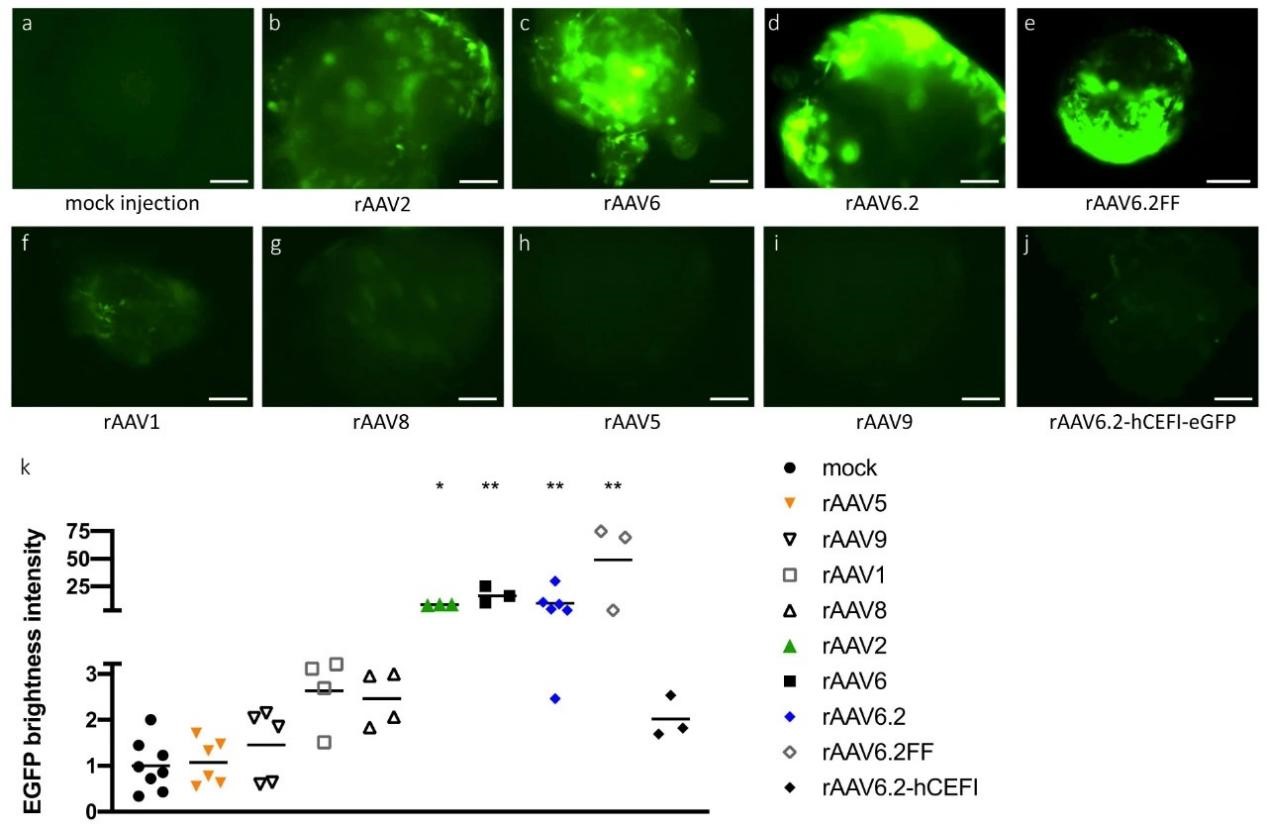Adeno-associated virus (AAV) is a highly efficient gene therapy vector that is utilized to deliver transgenes to a variety of different tissues in vivo, and it is currently being evaluated for using in the research of acute and chronic lung diseases including those caused by single gene defects such as cystic fibrosis, alpha-1 antitrypsin deficiency and surfactant protein B deficiency. The transduction efficiency of adeno-associated virus (AAV) vectors in Lung tissues is related to the AAV serotype and the route of administration. Here, we briefly provide some information that you need think about when get started with AAVs in lung.
Serotype need to be selected when use AAV in Lung?
Adeno-associated virus (AAV) with serotype2, serotype5, serotype6 and serotype9 can archive high transduction efficiency of target genes in lung, but the specificity of infected cells is different. AAV2 capsids is mainly transduction Airway smooth muscle, those having AAV type 5 or 6 capsids show high transduction rates in airway epithelial cells, in a range that should be sufficient for treating lung disease.
|
Serotype |
Infection |
Infection site and degree |
Receptor |
|
AAV2 |
basal layer >>surface |
Airway cell: Low level or none
Alveolar cell: Low level or none
Bronchial epithelium: Low level or none
Airway smooth muscle: Medium level |
Heparin sulfate |
|
AAV5 |
basal layer >surface |
Airway cell: Medium level
Alveolar cell: Medium level |
PDGFR, 2-5 sialic acid receptor |
|
AAV6 |
surface |
Airway cell: Medium level
Alveolar cell: High level
Bronchial epithelium: Medium level
Airway smooth muscle: Low level |
Sialic acid glycoprotein |
|
AAV9 |
basal layer&surface |
Airway cell: Low level
Alveolar cell: Medium level |
Galactosyl glucose |
Studies also shown that animal models is also a consider factors when select serotypes in lung, mainly between mice, lower primates and higher primates. In mice and some lower primates, AAV5 and AAV6 are ideal choices to infect the lungs, for higher primates, AAV1 is the best candidate, while serotype2 is also used in the study of lung cancer.
|
Type |
AAV Serotype Recommendation |
|
Mice and lower primates |
AAV5/AAV6 |
|
Higher primates |
AAV1 |
|
lung cancer |
AAV2 |
 Meyer-Berg, H., et al., Stem Cell Res Ther, 2020.
Meyer-Berg, H., et al., Stem Cell Res Ther, 2020.
Which Promoter need to be selected in lung?
Promoters can be organism or tissue type-specific, which can help you restrict the expression of your transgene to a specific species or location. Promoters can also drive different levels of expression. CMV is a strong promoter that drives very high, ubiquitous expression in lungs. In addition, if you want to infect specific types of cells in the lung, you can also consider choosing a cell-specific promoter, such as the endothelial cell promoter ICAM2 or the smooth muscle cell promoter SM22α, which can achieve specific infection of endothelial cells or smooth muscle cells.
Injection Method
There are many methods for AAV to infect the lungs. The more commonly used methods include intranasal instillation, endotracheal intubation, and intratracheal injection. If the specific requirements for AAV infection in the lungs are low, intravenous injection, intraperitoneal injection, etc. Intratumoral injection can also be used when lung cancer tumorigenesis experiments are performed. The following table shows a comparison of different injection ways. If you want to know more, you can check the reference article or contact us at
sales@brainvta.com.
|
Method |
Targeting site |
Advantages |
Disadvantages |
Reference |
|
intranasal instillation |
Nasal epithelial cells
Tracheal epithelium
proximal and middle lobes |
Fast; easy to operate; Low equipment requirements; multiple doses possible |
Two people are required; Unable to deliver to the distal lobe |
Reference 2
Reference 3 |
|
endotracheal intubation |
Nasal epithelial cells
Tracheal epithelium cells
Proximal, middle and distal lobes |
Can reach to the distal lobe |
difficult in operation; Special equipment required; time consuming |
Reference 4 |
|
intratracheal injection |
Nasal epithelial cells
Tracheal epithelium cells
proximal and middle lobes
May target distal lobes |
Mainly for lower respiratory tract; Limited delivery to nasal epithelium |
difficult in operation; surgical skills required; Invasive |
Reference 2 |
BrainVTA is a gene therapy service company providing customized construction and, purity/titer/timely assured preparation of AAV( 1E12 to 1E17 vg/batch)for both basic and preclinical research of gene therapy.
If you are planning or designing a lung research project, please contact us at
sales@brainvta.com and we are more than pleased to discuss the best plan with the choice of AAV vector with you.
-Customized construct with over-express any genes (wildtype, mutant or synthetic)
-Customized silence/Knock-out/Knock-in any genes from any species.(Free design)
-Customized AAV/LV packaging service
-Novel peptide modified serotypes service
Reference
[1]. Meyer-Berg, H., et al., Identification of AAV serotypes for lung gene therapy in human embryonic stem cell-derived lung organoids. Stem Cell Res Ther, 2020. 11(1): p. 448.
[2]. van Lieshout, L.P., J.M. Domm and S.K. Wootton, AAV-Mediated Gene Delivery to the Lung. Methods Mol Biol, 2019. 1950: p. 361-372.
[3]. Santry, L.A., et al., AAV vector distribution in the mouse respiratory tract following four different methods of administration. BMC Biotechnol, 2017. 17(1): p. 43.
[4]. Das, S., et al., A simple method of mouse lung intubation. J Vis Exp, 2013(73): p. e50318.
